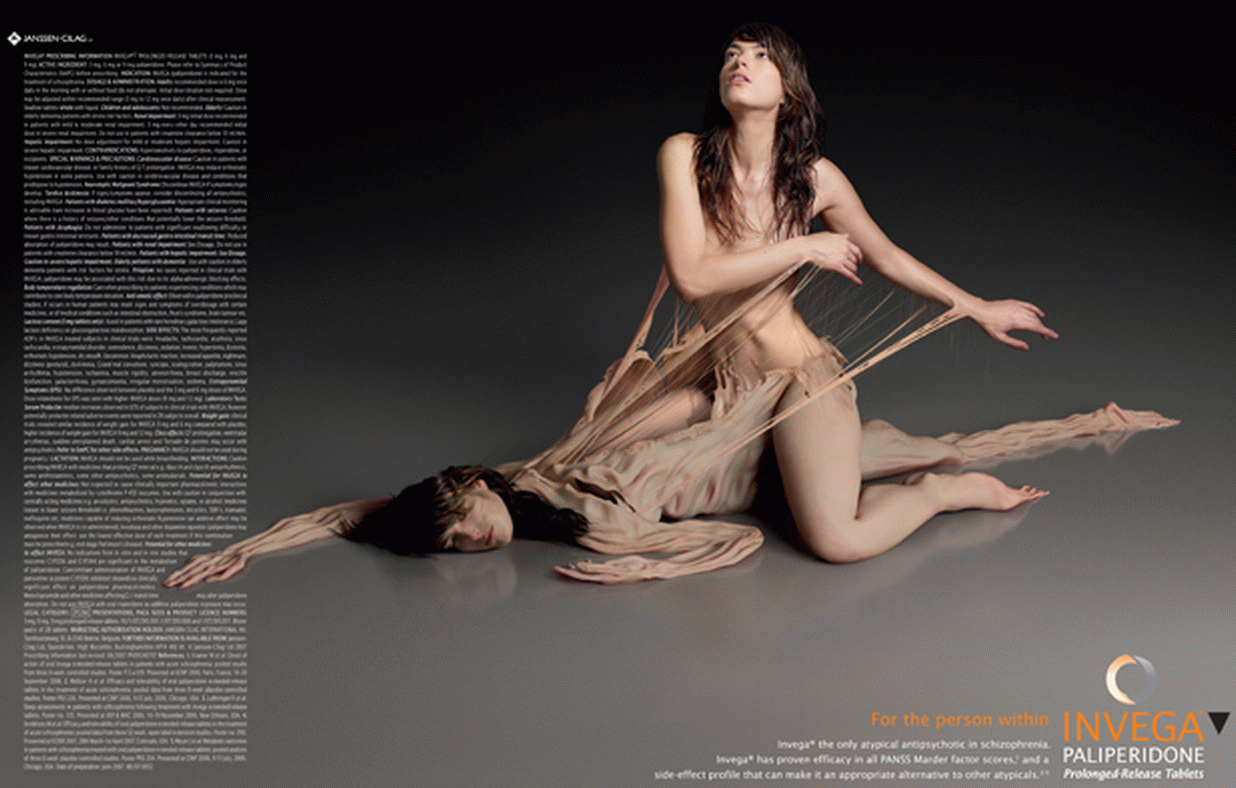

|
|
Invega advertisement, 2007 For the person within ~ INVEGA paliperidone ~ prolonged-release tablets Invega® the only atypical antipsychotic in schizophrenia. Invega® has proven efficacy in all PANSS Marder factor scores, and a side-effect profile that can make it an appropriate alternative to other atypicals. Treatment-emergent adverse events (TEAEs) reported in 5% or more of subjects treated with paliperidone prolonged-release tablets and at least twice the placebo rate were akathisia and other extrapyramidal symptoms including bradykinesia, cogwheel rigidity, drooling, dyskinesia, dystonia, hyperkinesia, hypertonia, hypokinesia, muscle rigidity, muscle spasms, musculoskeletal stiffness, oculogyration, trismus, parkinsonism and tardive dyskinesia. CASE AUTH/2047/9/07 -- PRIMARY CARE TRUST DIRECTOR OF STANDARDS v JANSSEN-CILAG The director of standards at a primary care trust complained about an advertisement (ref IBE/07-0052) for Invega (paliperidone prolonged release tablets) placed by Janssen-Cilag Ltd in Doctor, 18 September. Invega was indicated for the treatment of schizophrenia. COMPLAINT The complainant alleged that the advertisement breached Clause 9 of the Code in its unacceptable use of naked people and sexual imagery. When writing to Janssen-Cilag, the Authority asked it to respond in relation to Clauses 9.1 and 9.2 in particular. RESPONSE Janssen-Cilag refuted breaches of Clauses 9.1 and 9.2 as it considered that high standards had been maintained and that the advertisement did not depict naked or partially naked people for 'the purpose of attracting attention to the material or the use of sexual imagery for that purpose'. The depiction of a woman shedding her skin was a metaphor for the potential effect of this antipsychotic and the focus was on the efficacy of the medicine and the potential improvement of the patient's mental state subsequent to taking Invega. This was linked to the strapline 'For the person within'. The strapline further explained the image and it was important to view the piece in its entirety. The woman was not depicted clothed since an essential element of the concept was of 'shedding skin' to reveal 'the person within'. This image was not designed to be in any way sexual in nature and Janssen-Cilag was convinced that most health professionals would not find the image offensive or sexual in nature. Janssen-Cilag also contended that the image was not unsuited to the concepts of improving a patient's well-being within a psychiatric context and hence did not believe that its format or suitability were in breach of Clause 9. Janssen-Cilag, of course, would not wish to offend health professionals, and as such the image used in the advertisement had undergone market research testing, involving 43 psychiatrists, during the various stages of its development. The advertisement had also been prevetted by the Medicines and Healthcare products Regulatory Agency (MHRA); no issues of unsuitability of the image or taste were raised. Janssen-Cilag believed that the diligence undertaken during the development of this concept, which convinced it that the advertisement would not be likely to cause offence to the majority of health professionals, such that it would be consistent with the requirements of Clause 9.2, also demonstrated awareness of the requirements of Clause 9.1 and Janssen-Cilag contended that high standards had been maintained. While recognising differences in personal taste, the company was satisfied that the vast majority of health professionals viewing this advertisement would not find it offensive or sexual in nature. PANEL RULING The Panel noted that the advertisement featured a photograph of a young naked woman who was in the process of shedding her skin. The woman was positioned such that her torso was not completely visible. The Panel did not consider that in the context of the advertisement, noting in this regard the claim 'For the person within', the photograph was unacceptable in relation to the prohibition on the use of naked people or sexual imagery to attract attention. The Panel did not consider that the majority of health professionals would be offended by the advertisement. The Panel ruled no breach of Clauses 9.1 and 9.2. Complaint received 26 September 2007. Case completed 29 October 2007. Akathisia is an intensely unpleasant feeling characterized by muscle discomfort, inability to sit still, continuous agitation, restlessness, and fidgety feelings. Some patients say they feel like "jumping out of their skin.'' It is of interest that both patients reported here killed themselves by jumping. Kumar reports akathisia in a man with episodes of behavioral hyperactivity where he "ran or paced from door to door, tried to climb up walls and doors, tried to reach the nearest exit and get out through windows." Forrest and Fahn's patients complain of "a screaming inside" and their nonpsychotic patients exhibit "clinging behavior and anguished imploring of the physician to help." Van Putten described a schizophrenic woman who banged her head against a wall and cried, "I just want to get rid of this whole body." The same author described "aggressive and self destructive behavior" in another patient and a third patient who frequently ran away from the hospital during akathitic episodes. Keckich reports that a patient with akathisia became violent and tried to kill his dog. Shear MK, Frances A, Weiden P: Suicide Associated with Akathisia. Journal of Clinical Psychopharmacoly, August 1983. |